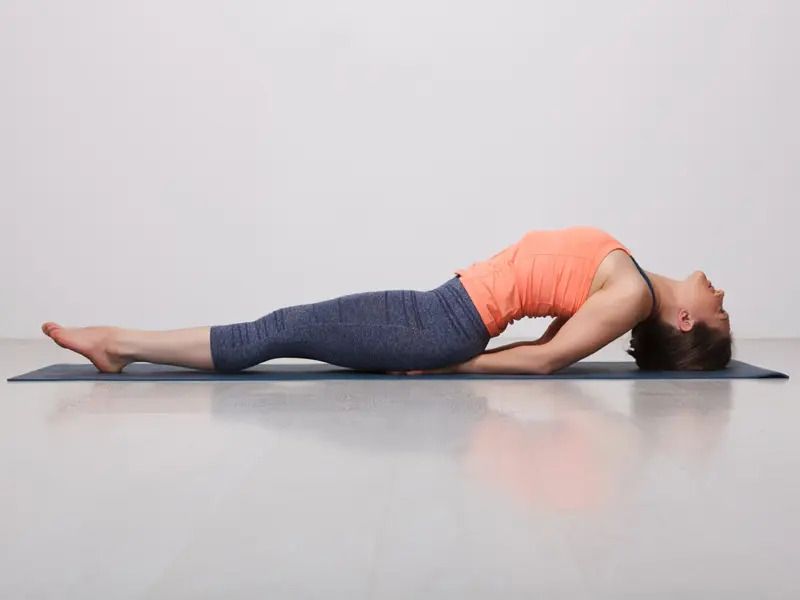We have divided the embryo pose practice into four parts: warm-up, main practice, follow-up, and things to keep in mind. This approach will help you find your balance faster in this seated yoga pose without injury.
Here are the four phases to get started with Garbha Pindasana.
Part 1 - Preparatory Poses for Garbha Pindasana
The embryo pose uses your abdominal muscles for balance, opens your pelvis, and it helps to increase the mobility in your knees. The following preparatory asanas will help you activate your knees, hips, and spine.
1. Sukhasana (Easy Pose) - Sit on your yoga mat in Staff Pose and gently bend your knees. Now, inhale as you cross your shins together and spread your sitting bones evenly on the ground.

Exhale and bring mindful awareness to your spine’s alignment. Sit with your spine upright, and avoid slouching your shoulders. Hold this pose with your eyes closed for five minutes.
2. Padmasana (Lotus position) - Sit in Staff Pose and bend your right knee. Bring your right foot over to your left thigh and repeat this same process on the left side.

Both your legs must appear crossed on the floor, and your feet should be resting on your opposite thighs. Now, close your eyes and maintain this hold with an straight spine for 2 to 5 minutes. You can chant a mantra or practice pranayama in this pose as well.
3. Gomukhasana (Cow Face Pose) - Start by getting into Dandasana and gently bend your right knee. Place your right leg under your left butt and over the right knee, and stack your left knee. Keep your feet aligned with your hip flexors.

Raise one arm overhead to reach behind your back and bring your other arm from below to get behind your back. Now, clasp and hold your fingers together and stay in this posture for a few minutes. Again, repeat the process by exchanging the placement of your arms and legs.
Part 2: Step-by-Step Instructions to Perform Garbha Pindasana
Below are steps to follow to get perform the Embryo Pose:
Step 1: Get into Padmasana and stay here for a few minutes while practicing some deep breathwork.
Step 2: Inhale, tighten your core and lift your legs off the mat in the same Padmasana formation.
Step 3: Now, pass your arms between the gap of your thighs and focus on balancing your body on your coccyx (a triangular arrangement of bone below your sacrum).
Step 4: Exhale and bring your arms close to your face or ears. Lock your legs with the support of your forearms.
Step 5: Focus on maintaining your balance in the Embryo Pose by closing your eyes and working on keeping your breathing steady.
Step 6: After one minute, let go of your arms and exchange the placement of your legs, repeating the same process once more.
Step 7: Finally, release the pose and bring your legs back into seated Padmasana.
Breath Awareness:
Inhale: When your legs are lifted off the yoga mat in Padmasana formation.
Exhale: When your arms pass through the gap to lock your limbs together.
Performance Duration for Beginners: Hold Embryo Pose for 30 to 60 seconds.
Performance Duration for Advanced: Hold Embryo Pose for 1 to 3 minutes.
Part 3: Things to Keep in Mind
If this is your first time performing Embryo Pose, follow the below posture cues for the best outcome:
Focus on your breathing: If you cannot balance the hold in Embryo Pose for very long, you may have an inconsistent breathing pattern. This is a challenging asana practice, and requires total concentration on balancing different muscle groups along with proper breathwork.
Do not try this as a beginner: Many beginners will find this pose to be too difficult to execute, which is why we highly recommend first building a foundational core strength and working on pranayama before getting started with this pose.
Part 4: Relaxing Poses After Garbha Pindasana
After practicing Embryo Pose, it’s important to relax your body with the below counter-poses:
1. Matsyasana (Fish Pose): From the last step of Embryo Pose, get into Staff Pose and start reclining your upper body onto your yoga mat.

Bring your elbows close together and place your forearms below your tailbone. Breathe in and lift your neck, chest, and low back off the mat. Hold this pose for a minute, and then relax into the Corpse Pose later.
2. Balasana (Child's Pose): After releasing Embryo Pose, inhale and transition into a tabletop pose. Spread your knees wide on the mat, exhale deeply, and bring your belly to rest in between your thighs.

Rest your chest on the mat and keep your arms stretched out in front. Hold this pose until your low and upper back muscles release any tension.
3. Supta Baddha Konasana (Reclining Bound Angle Pose): After Garbha Pindasana, transition into a seated Bound Angle Pose. Now, slowly start to recline your back onto the mat. Make sure to exhale as you lower your back.

Keep breathing as you widen your knees away from your hips and relax your pelvic floor and your spinal column. Stay in this pose until all of your exhausted muscles feel at ease.








